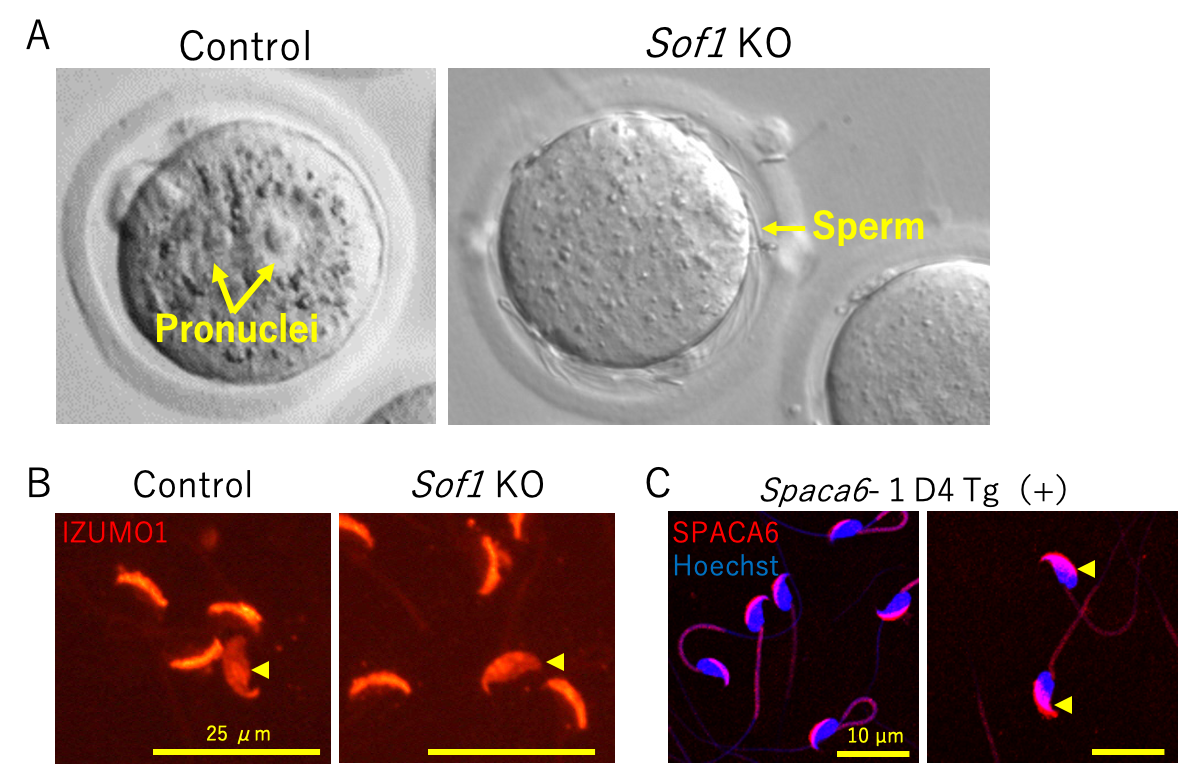Sperm proteins SOF1, TMEM95, and SPACA6 are required for sperm-oocyte fusion in mice (Ikawa Lab, in PNAS)
Sperm-oocyte membrane fusion is one of the most important events for fertilization. So far, IZUMO1 and Fertilization Influencing Membrane Protein (FIMP) on the sperm membrane and CD9 and JUNO (IZUMO1R/FOLR4) on the oocyte membrane have been identified as fusion-required proteins. However, the molecular mechanisms for sperm-oocyte fusion are still unclear. Here, we show that testis-enriched genes, sperm-oocyte fusion required 1 (Sof1/Llcfc1/1700034O15Rik), transmembrane protein 95 (Tmem95), and sperm acrosome associated 6 (Spaca6), encode sperm proteins required for sperm-oocyte fusion in mice. These knockout (KO) spermatozoa carry IZUMO1 but cannot fuse with the oocyte plasma membrane, leading to male sterility. Transgenic mice which expressed mouse Sof1, Tmem95, and Spaca6 rescued the sterility of Sof1, Tmem95 and Spaca6 KO males, respectively. SOF1 and SPACA6 remain in acrosome-reacted spermatozoa, and SPACA6 translocates to the equatorial segment of these spermatozoa. The co-expression of SOF1, TMEM95 and SPACA6 in IZUMO1-expressing cultured cells did not enhance their ability to adhere to the oocyte membrane or allow them to fuse with oocytes. SOF1, TMEM95, and SPACA6 may function cooperatively with IZUMO1 and/or unknown fusogens in sperm-oocyte fusion.
Significance
The sperm-oocyte fusion step is important to transport the male genome into oocytes. So far, IZUMO1 and FIMP have been identified as fusion-related proteins in spermatozoa, but the molecular mechanisms underpinning sperm-oocyte fusion and all of the proteins required for this essential process remain unclear. In this study, using CRISPR/Cas9 mediated gene knockouts in mice, we discovered that sperm proteins SOF1, TMEM95, and SPACA6 are required for sperm-oocyte fusion and male fertility. As these genes are conserved among mammals including human, they may explain not only the sperm-oocyte fusion process but also idiopathic male infertility and be unique targets for contraception.
Links
-
Phenotypic analysis of KO spermatozoa A) Sperm fertilizing ability with cumulus-intact oocytes in vitro. Fertilized eggs with two PN (2 PN) were observed in Sof1 control spermatozoa. However, Sof1 KO spermatozoa were accumulated in the perivitelline space, and there were no oocytes bearing 2 PN. B) Immunostaining of IZUMO1 in spermatozoa before and after the acrosome reaction. After the acrosome reaction, IZUMO1 in Sof1 KO spermatozoa spread out over the entire head (arrowheads), indicating that the IZUMO1 localization of Sof1 KO spermatozoa is normal. C) Localization of SPACA6-1D4 in the spermatozoa of Tg mice before and after the acrosome reaction. The sperm nuclei were labeled by Hoechst 33342. SPACA6 was localized to the acrosome cap before acrosome reaction and spread out toward the equatorial segment after acrosome reaction (arrowheads).
- Home
- Achievement
- Research Activities
- Sperm proteins SOF1, TMEM95, and SPACA6 are required for sperm-oocyte fusion in mice (Ikawa Lab, in PNAS)








